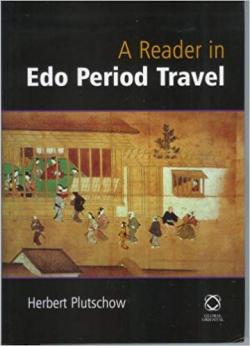A Reader in Edo Period Travel

By Herbert Plutschow
Global Oriental (2006)
ISBN 1-901903-23-0
Review by Sir Hugh Cortazzi
During the Edo or Tokugawa period, from the beginning of the seventeenth century to the Meiji Restoration in 1868, Japan largely avoided internal conflicts. The road system was developed not least to meet the requirements of the sankin kotai system under which the daimyo were required to travel from their domains to spend time in residence in Edo. Trade prospered and merchants and artisans generally thrived. The farmers, in theory second only to the samurai in the class hierarchy of Edo Japan, were squeezed to enable the samurai to maintain their artificially martial existence. Along the main roads posting stations and inns were established, but there was no wheeled traffic on the highways and movement was either on foot, on horseback or by palanquin. So journeys were slow and uncomfortable as good inns often could not be found. However the number of travellers grew and those with a literary bent and leisure kept diaries or records of their journeys.
As Plutschow points out in his informative introduction western studies of Tokugawa travel literature have tended to concentrate on the journeys made by poets where poems form the central feature. The most important examples of this genre in the Edo period were the travelogues of Matsuo Basho, the famous haiku poet of the seventeenth century whose Oku no Hosomichi has been the subject of a number of English translation. Plutscow notes that, with the exception of Donald Keene whose Travellers of One Hundred Generations, New York, 1989, which introduced a selection of Edo travellers, the bulk of Edo travel literature has been neglected by scholars partly because it was "not considered orthodox literature, especially 'the realistic accounts '" which Plutschow has selected for this volume.
Plutschow found that many of the more interesting and realistic writers of the period were either physicians or botanists. He suggests that the new "realism" stemmed from "Chinese honzogaku pharmacology and medicine." It is interesting in this context to note that Kaempfer, Thunberg, and von Siebold who provided the main sources for information about Japan to the West in the Edo period were all doctors to the Dutch merchant colony on Dejima at Nagasaki and also experts in botany.
Plutschow has selected sixteen travellers. He introduces each with a note giving necessary background and then translates selected extracts from their writings. Some of these are well known for other reasons. Kaibara Ekken was a famous Confucianist; Nagakubo Sekisui was an outstanding geographer; Motoori Norinaga was the leading kokugakusha who emphasised the study of early Japanese texts; Ueda Akinari was a novelist famous for his Ugetsu monogatari, a collection of nine tales of the supernatural; Shiba Kokan was a painter who adopted western techniques of perspective; Takizawa Bakin wrote one of the most famous long novels of the period, the Nanso Satomi Hakkenden; Watanabe Kazan was a famous portrait painter about whom Donald Keene recently published a biography under the title Frog in the Well. Plutschow pays particular attention to the travel writings of Furukawa Koshoken (1726-1807) and Sugae Masumi (1754-1829) whose travels took him in 1785 to Ezo (Hokkaido). He considers Sugae "a superb observer" and quotes some of his interesting observations on Ainu whom he had encountered. Plutschow comments: "we find in his diaries the same kind of fascination for the extraordinary, the exotic and a respect for cultural diversity we find in our other travellers (page 180)."
These writings are, of course, revealing about the personalities of the narrators, but they also tell us a good deal about conditions of life in the Edo period. Japan in those days was much more diverse than it became as a result of the centralising policies of the Meiji government. Much of the country was underdeveloped and poor. Shiba Kokan was critical of his country's backwardness: "the people of my country, Japan, do not study physics. Calling it elegance, they do not write the truth but express the feelings of an unstable woman using ornate language." We learn a good deal about the difficulties of travel with the need for passports and the checks made at the various barriers (sekisho). Takizawa Bakin left various revealing pieces of advice to travellers including "Think of the road as enemy territory and always be on the look-out" and "Eat only one or two bowls of rice for lunch and each time you get hungry, eat little. With a full stomach the going is painful."
Many of the accounts remind the reader that although peace had led to increased prosperity the Japanese peasant population had a very hard life and when the harvests failed were left to starve. There are also many interesting comments on the Dutch who were the only Europeans in Japan during this period and whose life style clearly intrigued the Japanese.
The book contains an interesting black and white plate section, but the single Road Map of Edo Japan is insufficiently detailed for any reader who wants to follow the itineraries of the various travellers. Ideally each of the travels recorded should have been accompanied by a fairly detailed sketch map. This would no doubt have involved much additional work, but it would have been invaluable for the serious student.

